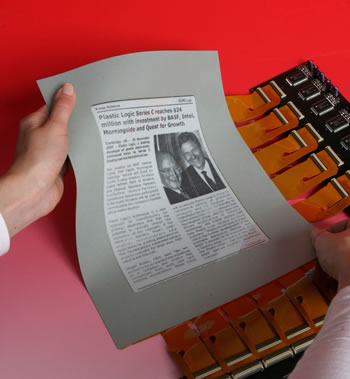Science Fiction
Dictionary
A B C D E F G H I J K L M N O P Q R S T U V W X Y Z
News E-Papers From Plastic Logic

"News E-Paper" sounds a bit cumbersome; why not just call them mediatrons? That has a nice futuristic sound to it. After all, if science fiction author Neal Stephenson wrote about them in 1995 in his novel The Diamond Age, shouldn't we give credit where it is due?
The first out of the gate, Belgium's De Tijd, another finance journal, uses the iLiad E-reader, developed by iRex Technologies, a spinoff of Royal Philips electronics. The daily economic paper Les Echos is now testing France's first papier électronique?. The device used is not flexible; it's more like a lightweight (less than a pound) tablet display.
These two prototypes being tested sound more like Arthur C. Clarke's newspad, which appeared in the 1968 book version of 2001: A Space Odyssey:
Bud took a seat and skimmed a mediatron from the coffee table; it looked exactly like a dirty, wrinkled, blank sheet of paper. "'Annals of Self-Protection,'" he said, loud enough for everyone else in the place to hear him. The logo of his favorite meedfeed coalesced on the page. Mediaglyphics, mostly the cool animated ones, arranged themselves in a grid. Bud scanned through them until he found the one that denoted a comparison of a bunch of different stuff, and snapped at it with his fingernail.
(Read more about Neal Stephenson's mediatron)
When he tired of official reports and memoranda and minutes, he would plug his foolscap-sized Newspad into the ship's information circuit and scan the latest reports from Earth. One by one he would conjure up the world's major electronic papers; he knew the codes of the more important ones by heart, and had no need to consult the list on the back of his pad. Switching to the display unit's short-term memory, he would hold the front page while he quickly searched the headlines and noted the items that interested him.
Truly light and flexible displays like those shown below from Plastic Logic in Britain are now in the pipeline, but were not quite ready for the current trials.
(Read more about Arthur C. Clarke's newspad)

(Flexible e-paper news article with graphics)
The flexible displays are black and white only, with 16 shades of gray. Advertisers are interested, despite the lack of color. These devices can have some programming along with the content; they can show coffee ads in the morning and beer ads in the evening, for example. Also, if the reader is standing in a WiFi hotspot, you could access more information from an ad, thereby combining the best of the web with the convenience of newspapers.
(Flexible e-paper video)
For other display-related news, see Node Explorer - Part Hitchhiker's Guide, Part Marauder's Map and Sony Reader Electronic Paper Book. There was a nice article on this in the New York Times this morning; unfortunately, you'll need to pay to read it. Try looking here and here for online sources.
Scroll down for more stories in the same category. (Story submitted 4/24/2006)
Follow this kind of news @Technovelgy.| Email | RSS | Blog It | Stumble | del.icio.us | Digg | Reddit |
Would
you like to contribute a story tip?
It's easy:
Get the URL of the story, and the related sf author, and add
it here.
Comment/Join discussion ( 0 )
Related News Stories - (" Display ")
iPhone Air Fulfils Jobs' Promise From 2007 - A Giant Screen!
'... oblongs were all over the floor and surfaces.' - Kazuo Ishiguro, 2021.
Transparent 4K OLED Wireless TV From LG
You will note that HG Wells also figured out the aspect ratio of the future!
DOTPad Braille Device Offers Live Access
Amazing tactile display.
Transparent MicroLED Screen From Samsung
Has Samsung nailed the Look of Things To Come?
Technovelgy (that's tech-novel-gee!) is devoted to the creative science inventions and ideas of sf authors. Look for the Invention Category that interests you, the Glossary, the Invention Timeline, or see what's New.
Science Fiction
Timeline
1600-1899
1900-1939
1940's 1950's
1960's 1970's
1980's 1990's
2000's 2010's
Current News
Natural Gait With Prosthetic Connected To Nervous System
'The leg was to function, in a way, as a servo-mechanism operated by Larry’s brain...'
Woman Marries Computer, Vonnegut's Dream Comes True
'Men are made of protoplasm... Lasts forever.'
Spidery 'Walk Me' Toyota Autonomous Wheel Chair Like Star Wars
Walk along with the emperor.
Dancing Robots Taught Dance Moves
'A clockwork figure would be the thing for you...'
Proof Of Robothood - Not A Person
'Who are you people? - Show 'em.'
Indonesian Clans Battle
'The observation vehicle was of that peculiar variety used in conveying a large number of people across rough terrain.'
The 'Last Mile' In China Crowded With Delivery Robots
Yes, it's a delivery robot. On wheels.
Tornyol Microdrone Kills Mosquitoes
'The real border was defended by... a swarm of quasi-independent aerostats.'
PLATO Spacecraft, Hunter Of Habitable Planets, Now Ready
'I ... set my automatic astronomical instruments to searching for a habitable planet.'
Factory Humanoid Robots Built By Humanoid Robots
'...haven't you a section of the factory where only robot labor is employed?'
iPhone Air Fulfils Jobs' Promise From 2007 - A Giant Screen!
'... oblongs were all over the floor and surfaces.'
ChatGPT Now Participates in Group Chats
'...the city was their laboratory in human psychology.'
iPhone Pocket All Sold Out!
'A long, strong, slender net...'
Did The Yautja Have These First?
What a marvel of ingenuity the little device was!
Jetson ONE Air Races Begin, Can Air Polo Be Far Behind?
'If you're one of those rarities who haven't attended a rocket-polo "carnage", let me tell you it's a colorful affair.'
Will Space Stations Have Large Interior Spaces Again?
'They filed clumsily into the battleroom, like children in a swimming pool for the first time, clinging to the handholds along the side.'
